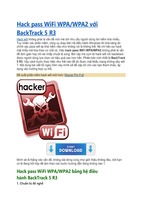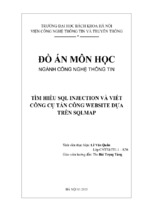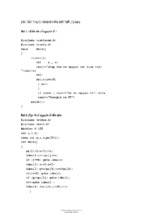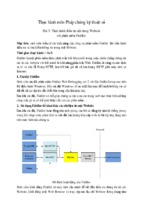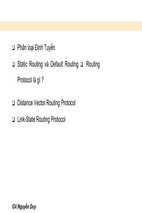194
CHAPTER 7 Social Engineering and USB
19. Type p for the second partition and press Enter.
20. Type 2 for your second partition number and press Enter.
21. When prompted, set the size of your second partition. Press Enter to accept the
default value for the first cylinder.
22. Press Enter to accept the default value for the last cylinder. This will allocate
the remaining space on your drive for the second partition.
23. Type t to change the partition system ID on your primary partition and press Enter.
24. Type 1 to select your first partition and press Enter.
25. Type b when prompted and press Enter. This will set your primary partition to
FAT32.
26. Type t to change the partition system ID on your second partition and press
Enter.
27. Type 2 to select your second partition and press Enter.
28. Type 83 when prompted and press Enter. This will set your second partition to
Linux.
29. Type a to set your primary partition to active and press Enter.
30. Type 1 to select your first partition and press Enter.
31. Type w to write the partition table out to disk and exit, and then press Enter.
32. Type fdisk –l to view your partitions and press Enter.
33. Type mkfs.vfat /dev/sd*1 to format the primary partition and press Enter.
34. Type mkfs.ext3 –b 4096 –L casper-rw /dev/sd*2 to format your second partition and press Enter.
Note
This next series of instructions will be used to make the drive bootable.
35. Type mkdir /mnt/sd*1 and press Enter.
36. Type mount /dev/sd*1 /mnt/sd*1 and press Enter.
37. Type cd /mnt/sd*1 and press Enter.
38. Type rsync -avh /media/cdrom0/ /mnt/sd*1 and press Enter.
39. Type grub-install --no-floppy --root-directory=/mnt/sd*1 /dev/sd*1 and
press Enter.
Note
This set of instructions will set up the persistent drive.
40. Type cd /boot/grub and press Enter.
41. Type vi menu.lst and press Enter.
42. Change the default 0 line to default 4. Using the down arrow key, navigate to 0.
43. Once the cursor is under the 0, type x to delete the character.
44. Type a and enter 4. The line should look like the following code snippet when
you are finished editing the line.
Hacking the Wetware
By default, boot the first entry.
default 4
45. Set the resolution to 1024 3 768 (or a relevant size to suit your configuration)
by appending vga 5 0x317 to the kernel line. The next steps will walk you
through this.
46. Using the down arrow key, navigate to the following line and place your cursor
a space after the word quiet.
47. Type a and add vga 5 0x317.
48. The line should look like the below code snippet when you are done.
title
kernel
Start Persistent Live CD
/boot/vmlinuz BOOT=casper boot=casper persistent rw
quiet vga=0×317
49. Type :wq! and press Enter to save your changes and exit vi.
50. Type reboot. Press Enter when prompted and remove the 2 GB drive.
51. Select Start Persistent Live CD. Alternately you can just wait 30 sec since we
set it to autoboot to persistent mode.
52. The system will boot to a command prompt by default. Type startx to initialize
the graphical user interface (GUI). To test persistence, all you need to do is create
and save a file then reboot again. If your file is still there, you are good to go.
If you will be using this build for penetrating a production environment, it is a
good idea to consider encrypting your drive. Instructions for this are contained on the
Backtrack site to aid in establishing an encrypted platform.H You will need to update
the Backtrack build in order to accomplish this, so if you are using a 4 GB flash drive,
you will be left with minimal space (approx 350 MB). Once again, consider using a
drive larger than 4 GB.
Pass the Hash, Dude
There are many ways to obtain the hash from a system, and two of the attacks in
this book will have this information available. The Switchblade approach pulls these
when deployed with administrator privileges, and a RAM dump will also contain this
information on any system that is running with an authenticated account. The attacks
outlined in Chapter 3, “USB-Based Virus/Malicious Code Launch,” Chapter 4,
“USB Device Overflow,” and Chapter 6, “Pod Slurping” can be crafted in a manner
that will extract this information. For this attack, we will be using the hash extracted
in Chapter 2, “USB Switchblade.”
The following downloads will be required to complete the instructions in this section. We will use the persistent version of Backtrack 4 built in the previous section.
• Samba 3.0.22 – This tool can be downloaded from http://us3.samba.org/samba/
ftp/old-versions/samba-3.0.22.tar.gz
Hwww.backtrack-linux.org/tutorials/
195
196
CHAPTER 7 Social Engineering and USB
• Add user patch () from foofus – This tool can be downloaded from www.foofus.
net/jmk/tools/samba-3.0.22-add-user.patch
• Pass hash patch from foofus – This tool can be downloaded from www.foofus.
net/jmk/tools/samba-3.0.22-passhash.patch
In this section, we will be installing the above tools simplify a pass-the-hash
attack. All of Microsoft’s authentication protocols – LAN Manager (LM), NT LAN
Manager (NTLM), NTLM2, and even Kerberos 5 – are vulnerable to this attack.
The Samba client approach can be performed on all with the exception of Kerberos.I
The instructions included below will walk you through the installation of this tool on
Backtrack 4 and illustrate a simple exploitation using a hash previously acquired.
1. Boot into Backtrack 4.
2. Type startx to launch the Backtrack 4 GUI. Figure 7.2 shows Backtrack initialized with the K menu activated.
3. If your network interface card is supported and you are on a Dynamic Host
Configuration Protocol–enabled network, you should have Internet access. If
you would like to connect to a wireless network, please follow steps 4 to 7.
4. Open a terminal window and type sudo start-network and press Enter.
5. Type cd /etc/init.d and then press Enter. Type wicd and press Enter again.
6. Click the K menu in the bottom left-hand corner of the Backtrack 4 GUI, navigate to the Internet menu, and launch WICD Network Manager.
Figure 7.2
Backtrack OS Showing K Menu
Iwww.sans.org/reading_room/whitepapers/testing/why_crack_when_you_can_pass_the_hash_33219
Hacking the Wetware
7. Find the access point to which you want to connect and click the small arrow to
expand the selection information, as shown in Figure 7.3. The wireless local area
network (WLAN) service set identifier (SSID) was removed to protect our privacy.
8. Click Advanced Settings and enter key information (change authenticating
type if necessary) if relevant, and click OK.
9. Select Connect, and it should establish the connection.
10. Download the samba-3.0.22 client tar ball and both foofus patches into /opt
using Firefox. This icon is located on the bottom toolbar. To download the patch
files from Firefox in Backtrack 4, right-click the link and select Save link as.
11. Go back to the terminal window and type cd /opt and press Enter.
12. Type tar xvfz samba-3.0.22.tar.gz and press Enter.
13. Type patch -p0
UNIQUE
MARKETING
<20>
UNIQUE
DOMAIN1
<00>
GROUP
Adapter address: 00:0e:35:af:58:e4
Hacking the Wetware
-----------------------------------NetBIOS Name Table for Host 192.168.1.67:
Incomplete packet, 353 bytes long.
Name
Service
Type
-----------------------------------STORALL
<00>
UNIQUE
STORALL
<03>
UNIQUE
STORALL
<20>
UNIQUE
STORALL
<00>
UNIQUE
STORALL
<03>
UNIQUE
STORALL
<20>
UNIQUE
__MSBROWSE__ <01>
GROUP
WORKGROUP
<1d>
UNIQUE
WORKGROUP
<1b>
UNIQUE
WORKGROUP
<1d>
UNIQUE
WORKGROUP
<1e>
GROUP
WORKGROUP
<00>
GROUP
WORKGROUP
<1e>
GROUP
WORKGROUP
<1b>
UNIQUE
Adapter address: 00:00:00:00:00:00
-----------------------------------NetBIOS Name Table for Host 192.168.1.101:
Incomplete packet, 173 bytes long.
Name
Service
Type
-----------------------------------SHIZSTUFF
<00>
UNIQUE
WORKGROUP
<00>
GROUP
WORKGROUP
<1e>
GROUP
SHIZSTUFF
<20>
UNIQUE
Adapter address: 00:1b:9e:2d:d6:b8
------------------------------------
Another interesting way to pass the hash is by way of the Nmap engine, as
described in a recent SANS publication.J You can also use Nmap for many things,
one of which is to determine listening ports and services on a particular target. The
below command example will provide you with this listing. In this example, a scan
of a network range was done like that described in the Nbtscan above.
nmap x.x.x.x/xx -T 4 -sV -P0 –n
J www.sans.org/reading_room/whitepapers/testing/scanning_windows_deeper_with_the_nmap_
scanning_engine_33138
201
202
CHAPTER 7 Social Engineering and USB
Below is a small sample of a large amount of data it returned. This is a very noisy
command, so do not run this on a production network unless they know what you
are doing.
ll 1000 scanned ports on 192.168.1.76 are closed
Interesting ports on 192.168.1.101:
Not shown: 988 closed ports
PORT
STATE SERVICE
VERSION
135/tcp open msrpc
Microsoft Windows RPC
139/tcp open netbios-ssn
445/tcp open netbios-ssn
5357/tcp open http
Microsoft HTTPAPI httpd 2.0 (SSDP/UPnP)
5800/tcp open vnc-http
TightVNC
5900/tcp open vnc
VNC (protocol 3.8)
8888/tcp open sip
Mbedthis-Appweb/2.4.0 (Status: 400 Bad
Request)
49152/tcp open msrpc
Microsoft Windows RPC
49153/tcp open msrpc
Microsoft Windows RPC
49154/tcp open msrpc
Microsoft Windows RPC
49155/tcp open msrpc
Microsoft Windows RPC
49158/tcp open msrpc
Microsoft Windows RPC
1 service unrecognized despite returning data. If you know the
service/version, please submit the following fingerprint at
http://www.insecure.org/cgi-bin/servicefp-submit.cgi :
SF-Port8888-TCP:V=5.00%I=7%D=1/24%Time=4B5C04E0%P=i686-pc-linuxgnu%r(GetR
SF:equest,B8,"HTTP/1\.0\x20302\x20Moved\x20Temporarily\r\nDate:
\x20Sun,\x2
SF:024\x20Jan\x202010\x2014:29:08\x20GMT\r\nServer:
\x20Mbedthis-Appweb/2\.
SF:4\.0\r\nContent-length:\x200\r\nConnection:\x20close\r\
nLocation:\x20ht
Notice the VNC service listening; somebody must have run USB Switchblade
on this system. This command returned all ports of listening services on that subnet range. Again, this is just a small sampling. Instead of enumerating services,
maybe you just want to check out some traffic to see what else you can find.
The below command will do a verbose dump of traffic on the network from the
attached device. In this example, the test machine was using the WLAN network
interface, so we indicated wlan0. If you are using a wired interface, then Eth0 will
probably apply. Use the ifconfig command to determine the active interface that
you are using.
tcpdump -i wlan0 –A -vv >> sniff.txt
14:16:14.579737 IP (tos 0x10, ttl 64, id 56185, offset 0,
flags [DF], proto TCP (6), length 64) 192.168.1.253.48149 >
Hacking the Wetware
192.168.1.67.ftp: P, cksum 0xa884 (correct), 1:13(12) ack 8 win
92
[email protected]@[email protected]...\.......
.-.z.Q..USER administrator
14:16:14.589275 IP (tos 0x0, ttl 64, id 32045, offset 0,
flags [DF], proto TCP (6), length 52) 192.168.1.67.ftp >
192.168.1.253.48149: ., cksum 0x3872 (correct), 8:8(0) ack 13
win 1448
E..4}-@[email protected]...?....8r.....
.Q...-.z
14:16:14.589723 IP (tos 0x0, ttl 64, id 32046,
offset 0, flags [DF], proto TCP (6), length 86) 192.168.1.67.
ftp > 192.168.1.253.48149: P 8:42(34) ack 13 win 1448
E..V}.@[email protected]...?.....&.....
.Q...-.z331 Please specify the passwor
14:16:14.589771 IP (tos 0x10, ttl 64, id 56186, offset 0,
flags [DF], proto TCP (6), length 52) 192.168.1.253.48149 >
192.168.1.67.ftp: ., cksum 0x3d99 (correct), 13:13(0) ack 42 win
92
E..4.z@[email protected].......?..sg...\=......
.-.}.Q..
14:16:15.441250 arp who-has 192.168.1.64 (Broadcast) tell
192.168.1.254
...........s...............@
14:16:16.442726 arp who-has 192.168.1.69 (Broadcast) tell
192.168.1.254
...........s...............E
14:16:16.443028 IP (tos 0x0, ttl 64, id 57257, offset 0, flags [DF],
proto UDP (17), length 71) 192.168.1.253.37429 > vnsc-bak.sys.
gtei.net.domain: [udp sum ok] 65303+ PTR? 69.1.168.192.in-addr.
arpa. (43)
E..G..@[email protected].....
14:16:16.468578 IP (tos 0x0, ttl 55, id 59551, offset 0, flags
[none], proto UDP (17), length 148) vnsc-bak.sys.gtei.net.domain
> 192.168.1.253.37429: 65303 NXDomain q: PTR? 69.1.168.192.inaddr.arpa. 0/1/0 ns: 168.192.in-addr.arpa. (120)
E.......7............5.5..H..............69.1.168.192.in-addr.
arpa................
14:16:17.164939 IP (tos 0x0, ttl 4, id 0, offset 0, flags
[DF], proto UDP (17), length 353) 192.168.1.67.33333 >
239.255.255.250.1900: UDP, length 325
[email protected].[NOTIFY * HTTP/1.1
HOST: 239.255.255.250:1900
CACHE-C
14:16:17.190319 IP (tos 0x10, ttl 64, id 56187, offset 0,
203
204
CHAPTER 7 Social Engineering and USB
flags [DF], proto TCP (6), length 68) 192.168.1.253.48149 >
192.168.1.67.ftp: P, cksum 0xc700 (correct), 13:29(16) ack 42
win 92
E..D.{@[email protected].......?..sg...\.......
.-...Q..PASS winT3r2009
14:16:17.224568 IP (tos 0x0, ttl 64, id 32047, offset 0,
flags [DF], proto TCP (6), length 52) 192.168.1.67.ftp >
192.168.1.253.48149: ., cksum 0x3428 (correct), 42:42(0) ack 29
win 1448
E..4}/@[email protected](.....
.Q...-..
14:16:17.235122 IP6 (hlim 1, next-header UDP (17) payload length: 154)
fe80::644c:d1a7:794c:c3f5.59230 > ff02::c.1900: UDP, length 146
`...............dL..yL...................^.l..<.M-SEARCH * HTTP/1.1
In this example, we were able to see an FTP connection on the wire with a username and password (in bold italics). When running this on a production environment, you will see a ton of interesting and extremely valuable information such as
passwords, usernames, and many other identifiable attributes. Users connecting to
nondomain and legacy resources will often pass these credentials in clear text.
Once your active information-gathering session is complete, you may want to
use Metasploit or another tool to exploit the identified vulnerabilities. There are
numerous tutorials on the Web in forums, blogs,K and other locations. One of the
best resources for Metasploit and other training information is Milw0rm’s Web site,
which was included in the tables provided at the beginning of this section. There are
many fun tools to play with in this penetrator’s paradise called Backtrack. It is not
enough to learn to hack; one must hack to learn.
Elevated Hazards
The risks here are literally off the charts. Companies are vulnerable not only from
the outside social-engineering avenue; insiders potentially pose the most danger. Any
disgruntled employee armed with a simple USB flash drive can boot his or her computer to this portable penetration platform and wreak an astonishing amount of havoc
against any and all available systems. Even worse, he or she could silently perform
privilege escalations, gaining access to sensitive or classified information, using it for
espionage, blackmail, competitor auctions, or any other number of nasty actions.
The tools provided in this chapter and the method applied make for a lethal combination. Credentials can be easily obtained though sniffing, brute force, or a number
of combinations, including social engineering. The employee can then masquerade as
another user, attach to the existing wireless infrastructure (or bring one of his or her
Khttp://synjunkie.blogspot.com/2008_02_01_archive.html
Elevated Hazards
own), spoof the MAC address, and remain in complete anonymity while performing
these brutal attacks. If the evil insider suspects detection, he or she can simply reboot,
hide the flash drive, and then socially engineer a way out of the dilemma. The operating system and applications typically used to govern the machine will have no control, event logging, or any other mechanism to prevent, track, or detect such activity.
A stringent NAC/IPS solution may provide ample defense, but even it will merely
delay the attacker, causing him or her to locate an alternate path.
Insiders aside, the external risk is ever-present and shows no signs of slowing
down. The manner in which these flash drives can be distributed is of an enormous
concern. These devices, preconfigured with the attacks outlined in the book, can be
labeled with what look to be legitimate logos of various vendors, then sent via mail,
placed in entryways, or even dumped into bowls at seminars and conferences to appear
as the common freebies usually sought after. The possibilities are virtually limitless
when it comes to the dissemination strategies an attacker may choose to deploy.
Legitimate Social-Engineering Concerns
Companies seeking to employ social-engineering engagements in their environments
should thoroughly evaluate the risks of applying such tactics. Organizations must
adequately prepare employees for this type of testing due to the potential consequences that may result.
The risks involved from a staff perspective include demoralization, frustration,
and resentment, often leading to other types of disgruntled behaviors. Each employee
will handle psychological stress in a different manner, and one must assume the
worst possible scenarios for all those involved. There are significant moral differences between tailgating or shoulder surfing and enticement by way of bribery or
other unethical solicitations. Notification of these types of events is in the best interest of all parties involved. At first glance, this may seem to contradict or undermine
this type of activity, but it can have tremendous benefits from multiple aspects.
A three-part series written by Mich Kabay summarizes key points in a paper
published by Dr. John Orlando on the ethical dimensions of social engineering as a
tool of penetration testing. “These observations allow us to draw up some guidelines
for the use of social engineering in penetration tests. Social engineering can be used
in situations to gain knowledge of a security program that cannot be derived in other
ways, but must be bound by ethical principles, including:
1. Just as human research guidelines demand that subjects are protected from
harm, social engineering tests should not cause psychological distress to the
subject.
2. Employees that fail the test should not be subject to public humiliation. The consultant should not identify an employee who fails a test to other employees or
even the employer, as it might undermine the employer’s view of the employee.
The information can be presented as part of an education program without identifying the employee.
205
206
CHAPTER 7 Social Engineering and USB
3. Independent oversight is an important component of human research protocols.
Just as universities have human research oversight committees, consultants should
get approval from at least two individuals at the organization before using social
engineering in a penetration test.
4. Testers should avoid any verbal misrepresentation or acting to establish the
deception.”3
Generations of Influences
Perhaps the most profound historical publication involving social engineering comes
from Sun Tzu in the The Art of War, written in 500 b.c. Virtually unknown to a majority
of the world until 1782, a French priest was said to have translated the first version.L
This and other interpretations that followed were said to have omissions and distortions
which ultimately polluted Tzu’s underlying philosophical perspectives. Included below
are a few translated samples of Tzu’s scripture that highlight the social-engineering
aspects. These statements are written in strict logical sequence, so to understand the
true meanings, one must read the entirety to achieve complete comprehension.
• Hence, when able to attack, we must seem unable; when using our forces,
we must seem inactive; when we are near, we must make the enemy believe
we are far away; when far away, we must make him believe we are near.
• If your opponent is of choleric temper, seek to irritate him. Pretend to be
weak, that he may grow arrogant.
• Hiding order beneath the cloak of disorder is simply a question of subdivision; concealing courage under a show of timidity presupposes a fund of
latent energy; masking strength with weakness is to be effected by tactical
dispositions.
• Do not repeat the tactics which have gained you one victory, but let your
methods be regulated by the infinite variety of circumstances.
• Gongs and drums, banners and flags, are means whereby the ears and
eyes of the host may be focused on one particular point.
• Do not pursue an enemy who simulates flight; do not attack soldiers whose
temper is keen.
• Knowledge of the enemy’s dispositions can only be obtained from other men.
• The enemy’s spies who have come to spy on us must be sought out, tempted
with bribes, led away and comfortably housed. Thus they will become converted spies and available for our service.4
Historically, you can find many other well-documented social-engineering efforts
around the globe. Odysseus’s infamous wooden horse in the Trojan War perfectly
exemplifies the exploitation of physiological firewalls – or lack thereof. Even the
Lwww.puppetpress.com/classics/ArtofWarbySunTzu.pdf
Generations of Influences
Bible has many examples throughout its scriptures, while none speaks louder than
the forbidden-fruit episode starring Adam and Eve.
Intelligence agencies probably have the most refined methods of social engineering. These techniques have had a strong impact throughout the world wars and
Cold War, and continue even in times of peace. Today, these agencies still employ
psychologists and sociologists in training programs, analogical roles, and advisors
of suggestiveness.M Prospective agents are grilled using these concepts to determine weaknesses in their psychological and mental aptitude and to determine if they
will divulge information sensitive in nature. The acronym MICE (money, ideology,
coercion, and ego) is also used to remind their agents of the high-level concepts
commonly used to perform these activities.
In today’s fast-paced information-technology world, social engineers are using
much simpler tactics to get the data they desire. Contractors and temporary agencies
constantly pursue new talent for short-term engagements and consulting gigs. It is
not uncommon for evil individuals to make themselves available for these short-term
assignments. This grants them immediate access to internal resources where they can
easily plant malicious code, keyloggers, or other items to stealthily steal sensitive
information.
Publically available records are a growing source of valuable information for
these would be attackers. Executive biographies can be found on nearly all corporate
sites, and this information can lead to disastrous consequences. Their alumni status,
graduation timelines, and hobbies are commonly placed in these descriptions that
give just enough information for a cleverly crafted social manipulation maneuver.N
A simple e-mail disguised as an alumni golf tournament could be enough to entice a
response. The attack could then direct the executive to a Web site where he or she is
asked for credit card information in order to retain a position.
Social networking sites potentially pose the most danger, as corporations are now
embracing these as they grow in popularity. Personal pages already present a plethora
of knowledge on any given individual. Favorite hangouts, elaborate photos, chronological events, family, and friends top a humongous list of priceless items any and
every attacker would want to gather for intelligence. Determining where a worker
frequently partakes in frosty beverages can be an enormous advantage. An introduction and intelligence gathering in this environment is extremely easy, as most are
willing to accept free shots of truth serum from anyone. Hacking into these sites is a
trivial matter, and once accomplished, impersonation of an established contact will
significantly aid their efforts.
Seven Deadliest Social Network Attacks (ISBN: 978-1-59749-545-5, Syngress)
by Carl Timm provides an in-depth look into the evolving dangers and dire consequences which can occur.
Mwww.hg.org/article.asp?id=5778
Nwww.informit.com/articles/article.aspx?p=1350956&seqNum=5
207
208
CHAPTER 7 Social Engineering and USB
USB Multipass
Now that you have created all of these independent USB tools and bootable operating environments, you are probably thinking a separate key chain might be in order.
Before you take that step, you might want to check out some of the recent initiatives
out on the Web involving multiboot USB configurations. The Hak.5 clan has one
of these projects in the works and labels it the USB multipass. There are several
videos,O forum threads,P and blog entriesQ available online to help establish yourself
as a lord of the USB. Some additional bootable options you may want to consider
are included below:
• Trinity Rescue KitR is another live Linux distribution that is specifically designed
for recovery and repair situations. It can run offline virus scans (multiple vendors), adjust passwords, crush rootkits (currently only for Linux and UNIX),
perform data extraction, and much more. This is a must-have tool for system
administrators of all sorts.
• Kon-BootS is an awesome password-popping program for most Linux and
Windows (XP, 2003, Vista, 2008, 7) versions. It changes the contents of the
Windows kernel during boot to allow you to gain administrative or root access
with minimal modifications on the target systems.
• Darik’s Boot and NukeT (DBAN) is a bootable image that securely wipes all data
from a majority of hard-disk types. This tool is a must-have for those who engage
with HIPAA, PCI, DoD, or other regulated clients.
• Macrium ReflectU is an awesome disaster recovery solution to have at your ready
for the worst occasion. Similar to Symantec Ghost, it can clone data to a new
drive or store the image away for backup purposes.
Thwarting These Behaviors
Prevention of social engineering is not a trivial task by any means. Concerns surrounding these tactics have pestered paranoid professionals since the dawn of time.
Those concerned are continuously refining conscious efforts to thwart new techniques as they arise. The following sections will discuss some of the latest defensive
strategies that are being applied.
Security Awareness and Training
In Chapter 5, “RAM dump,” we touched on the internal security issues that constantly challenge a majority of the IT industry on a regular basis. Unauthorized and
Ohttp://revision3.com/hak5/usbmultipass
Phttp://forums.fedoraforum.org/archive/index.php/t-217113.html
Qhttp://team140.com/2009/08/20/the-multipass-usb-project/
Rhttp://trinityhome.org/Home/index.php?wpid=1&front_id=12
Shttp://piotrbania.com/all/kon-boot/
Twww.dban.org/download
Uwww.macrium.com/reflectfree.asp
Thwarting These Behaviors
unintentional actions by legitimate IT and general staff persist like a plague without
a cure. A large part of this can be attributed to an inability to interpret concepts, best
practices, and rules set forth by training and corporate policies. The cold, hard truth
of this matter is that some find these extremely boring and repetitive, while others
are unable to comprehend the true risk and intentions behind this training material. Attempts to reach all individuals with a single training regimen will continue
to fail.
Each person in an organization plays a crucial role in the success of a solid
security training and awareness program. Business leaders’ responsibilities are
much greater in that they must ensure effective dissemination of the information
throughout the corporation. NIST Publication 800-50,V “Building an Information
Technology Security Awareness and Training Program,” supplies guidance for erecting an effective starting point from which to build upon. This paper was written to
support requirements issued by the Federal Information Security Management Act of
2002. Included below are five additional considerations for your organization.W
1. Realize that awareness and training are separate entities that must be combined to
gain a holistic experience. Educating organizations on security is different from
how they attain awareness.
2. Establish goals for this program with a firm scope to drive the initial ideology
forward. Combine measurements and feedback, and make constant adjustments
to keep the material fresh and enlightening.
3. Random interviews should be performed for staff at different levels to determine
how the training was perceived. Be sure to affirm that the interview is to establish
opinions on the subject of security and material provided instead of approaching
this as a test to establish individual aptitude.
4. Saturate the organization with different levels and types of material. Training
should be tailored to specific groups of individuals who encounter different risk
levels. Sales staff, remote employees, and home workers will require a different
degree of training than others. Treat training and awareness as a program that
requires tracking and measurement of progression.
5. Small organizations should not be afraid to consult subject-matter experts in
this field. This can provide a wealth of knowledge to build an effective program
moving forward. Large entities need to employ other groups within the organization, as they may have different requirements or need to market to an alternate
audience.
If you are an employee of an organization, do not hesitate to reach out to management regarding your views on training and awareness. Constructive suggestions can
go a long way in bolstering a somnolent training regimen and may even foster the
development of your career.
Vhttp://csrc.nist.gov/publications/nistpubs/800-50/NIST-SP800-50.pdf
Wwww.cisohandbook.com/Default.aspx?tabid=381&language=en-US
209
210
CHAPTER 7 Social Engineering and USB
Behavioral Biometrics
The emerging technology known as video analytics refers to software that is used to
analyze captured information for objects, activities, attitudes, or other specific data.
This software applies algorithms against the camera’s output to detect and sometimes
react to specific scenarios that may occur. Behavioral recognition can use these algorithms to identify misplaced objects, reverse movement, or other odd actions that
might signify criminal conduct. Most of these solutions require expensive, specialized cameras to allow the operation of analytics in real time.
Warning
Advanced camera technologies are still beyond most budgets. Analog solutions are becoming
more affordable, although economic conditions might still be a factor. If you are a business
owner contemplating the installation of dummy cameras, consider consulting an attorney in
your country or state to determine if relevant laws may induce liability. Some courts in the
United States have sided with plaintiffs in lawsuits filed on various grounds. Liabilities could
also arise for broken or improperly configured equipment, especially if contracts, agreements,
advertisements, or other documents cite increased safety for surveillance installations.
Facial recognition is one of the more prominent areas in the video analytical realm
and has seen as much development as it has scrutiny. Airports have been advertised
as one of the primary beneficiaries of this technology, as promoters claim it can be
used to spot known terrorists or other criminals against predefined watch lists. In the
past, two-dimensional recognition has been used, and while it has many limitations,
it has had some degree of success, as shown with the results of an implementation at
Superbowl XXXV in Tampa Bay, FL, January of 2001.X Three-dimensional recognition is a recent addition that shows promise and has numerous customers currently
using it for entry authorizations. Limitations still exist, including sunglasses, excessive
hair, reduced lighting, low-resolution images, side profiles, range, and other obstructions that may be present. These systems are also less effective when individuals use
expressions such as smiling, distress, or other excessive changes. Strangely enough,
some governments are now requiring neutral expressions for passport photos.Y
The Department of Homeland Security has funded an interesting pursuit under the
broader scope of Human Factors Behavioral Sciences Projects,Z which takes privacy
data mining to a whole new level. One program of interest called Future Attribute
Screening Technologies (FAST) has enormous potential that can be gauged by the
level of irritation it has triggered in privacy advocates.AA This undertaking is combining a number of technologies to supply an early-detection mechanism for aggressive,
evasive, or terroristic behaviors. FAST is currently using a series of sensors consisting of enhanced cameras, infrared heat signatures, and laser radar (Bio-Lidar) to
Xwww.wired.com/politics/law/news/2001/02/41571
Ywww.ppt.gc.ca/cdn/photos.aspx?lang=eng
Zwww.dhs.gov/files/programs/gc_1218480185439.shtm#19
AAwww.darkgovernment.com/news/future-attribute-screening-technology-raises-privacy-concerns/
Thwarting These Behaviors
assess pulse, breathing rate, and other attributes from afar.BB The FAST organization
claims the premise behind the project is to aid security staff in choosing suspicious
individuals to probe.
Epic Fail
Using advanced analytics, biometrics, and other evolving entry-protection technologies will
not hinder proximity-based social-engineering activities. These may one day provide the
necessary measurement to detect and deter these performances but are still far from reach.
In 2002, scientists at the University of Sussex in England adapted different technologies aimed at another organ to gain a similar outcome.CC Using electroencephalogram (EEG) technology, they provided potential theories on how to remotely probe
the brain for certain activities. Researchers at the Drexel University’s College of
Medicine in Philadelphia feel near-infrared light sensors may provide a better solution
for remote cognitive assessments.DD Functional magnetic resonance imaging (fMRI)
technology is probably the most advanced in the brain space, boasting a 90 percent
accuracy rate in detecting lies, although the bulky equipment and high cost make it
less likely to be adopted for remote usages.EE Both the EEG and infrared technologies
still require physical probes attached to the subject, but with heavy government funding and a lack of recent reports, one has to wonder what we are not being told.
Perhaps the most interesting new technologies with remote brain-peering potential are those using terahertz frequencies. This wavelength lies between 30 mm and
1 mm of the electromagnetic spectrum in the middle of infrared and microwave.
Already in use in the Detroit courthouse,FF this technology has enormous potential that can passively differentiate between flour and cocaine hidden on a person’s
body at 30 ft.GG The devices are already the size of a shoebox and have the ability
to permeate a vast range of materials including fabrics, plastics, wood, brick, and
even human tissue and bone. While memory-reading capabilities are still in their
infancy, the ideas behind this are quite thought-provoking – pun intended. The future
of remote-probing brain analysis is almost certainly that of terahertz technologies.
Windows Enhancements
Possibly the most relevant security enhancement brought forth by Windows 7 is
the extension of BitLocker encryption for removable drives.HH Dubbed BitLocker
BBwww.newscientist.com/blogs/shortsharpscience/2008/09/precrime-detector-is-showing-p.html
CCwww.sussex.ac.uk/pei/documents/applab813284_1.pdf
DDwww.biopac.com/Manuals/app_pdf/fnir_ieee_cognition.pdf
EEwww.wired.com/wiredscience/2009/03/noliemri/
FFwww.policeone.com/police-products/for-cops-by-cops/articles/1728216-Detroit-courthouse-gets-
new-contraband-detection-system/
GGwww.ballerhouse.com/2008/03/10/thruvisions-t5000-security-camera-detects-guns-bombs-and-
cocaine/
HHwww.winsupersite.com/win7/ff_bltg.asp
211
212
CHAPTER 7 Social Engineering and USB
to Go (BTG), this update is quite similar to its local drive counterpart. While it is
technically feasible to apply BitLocker encryption to a removable drive in Vista, this
is not a supported feature.
BTG simply expands the volume-level encryption functions to include removable drives. Using a three-key system, the removable drives can be encrypted with
AES 128- or 256-bit-based full-volume encryption key (FVEK). Regardless of the
choice, the full key size will remain 512 bits because it will be padded with additional key material. The FVEK will be encrypted with 256-bit AES based on the
volume master key that leverages the Key Protector that is based on the user-defined
password.
Warning
BTG only supports FAT and FAT32 file systems for encryption. It is possible to successfully
encrypt NTFS removable drives in Windows 7, although these drives will not operate with
Vista and XP systems.
The BTG implementation works similar to that of TrueCrypt and other volumelevel encryption products, but it is much easier to use and manage. To apply BTG to
a flash drive, you need only to complete the following steps:
1. Insert the flash drive into a Windows 7 system.
2. Click Start, then go to My Computer.
3. Select the flash drive icon, and then right-click.
4. Select the option to Turn on BitLocker.
5. Once BitLocker initializes the drive, you will be prompted to enter a password or
an alternate authentication mechanism. Choose the appropriate option and select
Next.
6. Choose the recovery option that best suits your needs. It is not recommended to
save these keys on another encrypted volume.
7. Now, click the Start Encrypting option, and once complete, a lock and key symbol will be present on the drive.
BTG not only protects data on removable drives but also includes manageability to
enforce encryption and backup of recovery key. Additionally, you can force Windows 7
systems to allow only BTG-encrypted removable drives. This is a very intriguing
option, considering some of the attacks outlined in this book, especially those with
preconfigured drives left lying around for individuals to insert them. Theoretically,
one would merely need to encrypt the preconfigured drives with BTG and then
entice the user with social engineering to supply authentication, which would then
deliver the desired payload. Apply this theory similarly to a Hacksaw-infected
system, and the data on the encrypted drive could also be distributed to an unwanted
party post-authentication. All speculation aside, this is a strong step in the right direction for Microsoft systems.
Thwarting These Behaviors
Tip
Windows XP and Vista users will need to download a separate component to view
BTG-encrypted devices. You can retrieve this software at www.microsoft.com/downloads/
details.aspx?FamilyID=64851943-78c9-4cd4-8e8d-f551f06f6b3d&displaylang=en
The downside to this added protection is that Microsoft is only including these
features on Enterprise and Ultimate editions of Windows 7 releases. This is no
surprise to those familiar with Vista, as the BitLocker feature is only available to
these premier editions as well. However, this does bode well for third-party products to fill the gaps for these lesser versions. Be wary of USB devices that include
encryption onboard the device. Recent attacks have cracked FIPS Level 2 protection
mechanisms used on some high-profile name brands.II
Windows Group Policy has also been overhauled with the release of the 2008
Server platform. There are several hundred new policies that have been included in
addition to the enhancement of existing elements.JJ Some of the more interesting new
options include the following:
•
•
•
•
•
•
•
Removable storage restrictions
Network access protection
Device installation control
Power management
Printer-driver installation delegation
Hybrid hard disk
User Account Control
Windows Server 2008 has also finally included removable media options in their
administrative templates. In Chapter 6, “Pod Slurping,” instructions were provided to
build a custom template for Windows 2003 Active Directory Group Policy. Included
in Figure 7.6 are the updated objects supplied by default. These can only be applied
on devices that are not currently in use. This could be an issue, as some users will
leave media or peripherals constantly engaged. Take this into consideration before
planning a change of this sort.
Once these settings are applied to a system, a restart is required before activation
will occur. The “Time (in seconds) to force reboot” will allow you to automatically
reboot the system after the policy is applied. This will allow you to apply different reboot intervals for regional system groupings to ensure users are not affected.
Figure 7.6 shows the default objects included in Server 2008.
From a Windows 7 Local Policy perspective, you can also adjust these new
options. Figure 7.7 depicts the newly added Removable Data Drive features at this
level.
IIwww.h-online.com/security/news/item/NIST-certified-USB-Flash-drives-with-hardware-encryptioncracked-895308.html
JJhttp://technet.microsoft.com/en-us/library/cc725828%28WS.10%29.aspx
213





